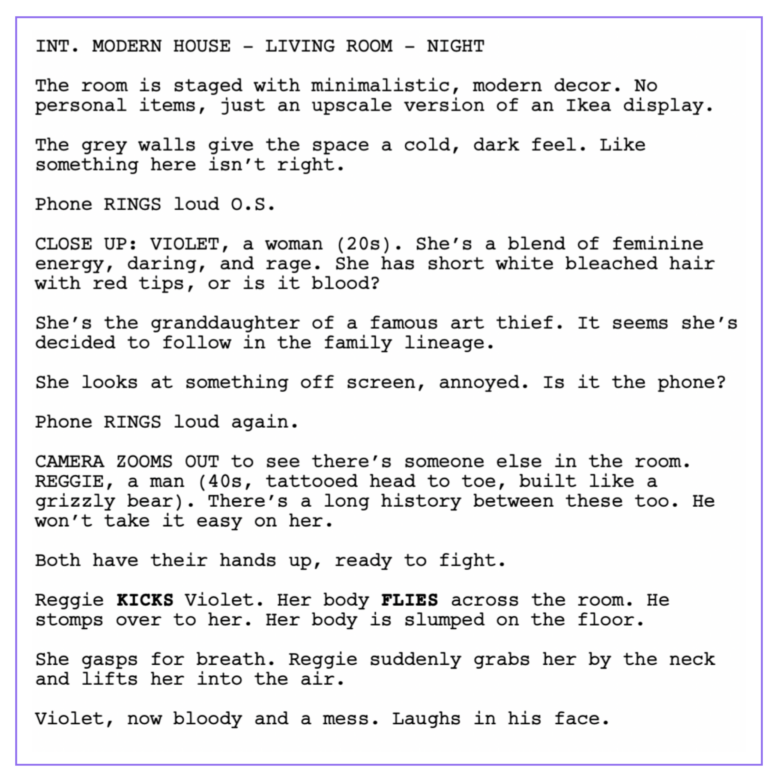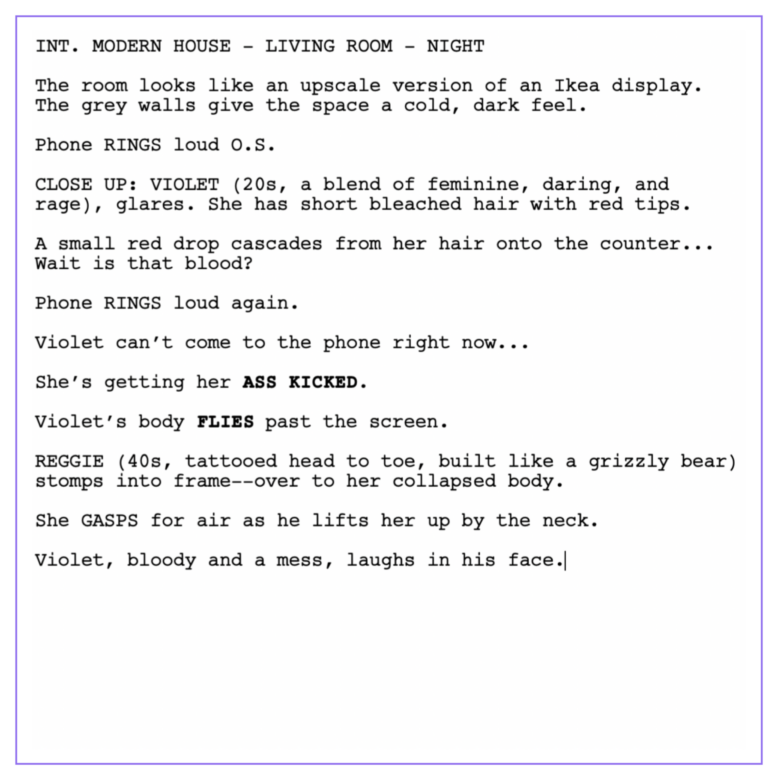Screenwriting Rules: The Only One that Matters – Don’t Be Boring
Forget the “Rules” of Screenwriting
Don’t write camera directions. Don’t describe what can’t be seen or heard on screen. And whatever you do…never…I mean never say, “we see.” You’ve heard all these screenwriting rules before. But here is the truth: none of that matters if the reader is hooked.
The only real screenwriting rule that matters is simple: DO NOT be boring.
Well, there is one more rule. Be clear. If your reader is confused and you are not writing a mystery, that is also a problem.
The script is not the final work of art. It’s more like a curated chef’s tasting menu. As you read through it, you can sense what flavors you might expect. You see the ingredients they’ve chosen, the combinations they’re experimenting with, and you start to imagine how it will all come together. But it’s still just a hint of what’s to come, not the actual finished work of art.
Because of this, your job as a screenwriter is to serve that tasting menu in a way that gives the reader a clear, cinematic vision. You want them to see the movie in their mind, feel the emotions of the characters, and be drawn into the story. If they are invested after reading and want to “taste” the film, you have succeeded.
That brings us to the next big question: if rules don’t really matter, what about formatting?
Formatting: Rules or Guidelines
Yes, formatting has rules. You should know what a scene heading is. You should know what a properly formatted script looks like. If you write your entire screenplay in bright blue Comic Sans, no one is going to take it seriously.
But beyond that, formatting rules are not meant to box you in, like some would have you believe. Like Captain Barbossa says in Pirates of the Caribbean:
“The code is more what you’d call ‘guidelines’ than actual rules.”
The same goes for screenwriting. The guidelines exist so that if it goes to production, the filmmakers are able to film the script. Things like scene headings actually serve a purpose during production. So it’s important to learn the craft and let it serve your story instead of limiting it.
If you are unsure about formatting, start by reading produced screenplays. You can often find them online by searching “Movie Name” PDF. Just make sure you are reading a real script and not a typed-up transcript.
A few resources we like include:
- For produced TV pilots: https://sites.google.com/site/tvwriting/
- John August’s Formatting at johnaugust.com/qanda/formatting for reliable insights from a professional writer.
- Kill the Dog by Paul Guyot
- That’s Not the Way It Works by Bob Saenz
- The Hollywood Standard by Christopher Riley for ideas on how you could format something.
None of these are absolutes, but they can help you if you don’t have any experience in something like formatting a montage.
So Why Are You Getting Notes About “Breaking Screenwriting Rules” Then?
If you’ve ever received notes like:
- “You can’t use camera directions. You’re not the director.”
- “Don’t direct the actors. They will get offended if you try to tell them how to act.”
- “Cut ‘we see’. It takes us out of the story.”
- “Don’t describe what can’t be seen or heard on screen.”
Sometimes it’s because you got a script reader who doesn’t know what they’re doing. Many readers are interns still in college. They’re learning these so-called screenwriting rules in class and because they don’t understand how little they know about what makes a script great, they focus on those “rules” instead of your story. Yes, the system is broken and at times, it sucks.
However, the readers that matter will not care about those things. Many professional screenwriters break those so-called screenwriting rules. So if you can do them, then why are you hearing that note? It’s because you’re just not doing them well.
I have given these notes to newer writers before as well, and I promise it’s not hypocritical. The note might have sounded the same, but the reasoning was different. I didn’t tell them to cut a camera direction because they aren’t the director. I told them to cut it because it wasn’t adding anything to the story. Worse, it was actually trying to cover for the fact that their story wasn’t interesting to begin with. They thought the camera angle would make it engaging. It didn’t.
When Camera Directions Work and When They Don’t
Camera directions can be useful, but only when they elevate the storytelling. Many newer writers use them to make a dull scene feel exciting. The problem is, if your story and characters are not interesting, no camera angle will save it.
You can absolutely use camera language such as CLOSE UP, ANGLE ON, or PUSH IN if it enhances the story. Use it to create surprise, build tension, or guide the reader’s focus. Just do not use it as a distraction from weak writing.
Remember that you are not trying to direct the film. You are trying to make the reader see the film in their mind. If the direction helps that vision come alive, it has a place on the page.
“Don’t Write What We Can’t See or Hear” — Kind Of
Another misunderstood rule is “only write what we can see or hear.” On paper that sounds simple, but in practice, it is about balance.
You should not waste half a page describing the smell of a room or what a character’s childhood trauma feels like. But you can use sensory shorthand that helps the reader visualize the moment.
For Example:
“It’s the kind of room that smells like wet dog.”
You cannot literally see that, but it paints a vivid image in one quick line. It gives the reader a sense of the place without slowing the story down. That is good writing.
It is not something the camera captures, but it deepens the reader’s experience. Use these tools carefully, but do not be afraid of them.
Examples that Break the “Rules”
Here are two versions of the same scene that break the supposed screenwriting rules. However, we see the second version is leaner and stronger. It doesn’t waste time giving the reader information they will find out later in the script.
Scene 1: The Wrong Way:
This scene relies heavily on things like descriptions we can’t see, unnecessary camera directions, and is too wordy.

For Example:
“She’s the granddaughter of a famous art thief. It seems she’s decided to follow in the family lineage.”
This tells us information that should be revealed later through character and action. It flattens the moment and kills mystery.
Scene 2: The Right Way:
This scene doesn’t overstay its welcome and throws you into the middle of the action without unnecessary details. However, it clearly still displays the writer’s unique voice and would save pages in the overall script.

For Example:
“VIOLET can’t come to the phone right now… she’s getting her ASS KICKED.”
You cannot literally see “she can’t come to the phone,” but the line creates humor, tone, and voice. It engages the reader.
Also, in both examples, a camera direction like CLOSE UP could be used effectively if it adds impact, such as revealing a surprise character in the room. The goal is not to obey or defy the rules. The goal is to make your script feel alive and make the read as enjoyable as possible.
Unearth the Gems
Even great details can weigh your script down. In screenwriting, less is almost always more. Tight writing keeps readers engaged and the story moving. Clarity and pacing matter more than fancy language.
Cut anything that slows down the read or does not enhance the script. If it is entertaining and fits the world you have built, keep it. If the moment needs space to earn its emotion, keep it. But if it is an extra line describing a room that adds nothing, cut it.
Every word you remove makes your script read faster. Do not avoid style. Use it with purpose. Make your prose cinematic, sharp, visual, and to the point.
If You Think Your Script Isn’t Boring but No One Is Sharing It
Sometimes a script feels exciting to you, but it is not getting passed around in the industry. That is a red flag. You might be too close to your own work.
You should be excited about your script. You accomplished something great. You wrote a script, and that is something most people never do. But if you are not genuinely excited about it, do not send it out. Wait until it feels undeniable.
At the same time, excitement is not enough. You have to look at your work objectively. Do others think it is incredible? Not good, not even great, but incredible. Would someone be willing to invest millions of dollars to make your story come to life? Remember, this is a business. Every time you send out a script, you are asking someone to take a financial risk on you and your writing.
If your script is not getting traction, it’s probably not because of formatting or small mistakes. And it’s definitely not because you’re breaking an imaginary list of screenwriting rules. It’s because it’s not as compelling and undeniable as you think. Something is missing. And if no one wants to send your script on, it means you are not a good investment yet. The key word is “yet.” Keep learning, improving, and pushing yourself until you are.
How to Make Sure Your Script is Not Boring: A Quick Checklist
✅ Is every scene unique and interesting?
If you have a familiar genre beat such as a training montage or a breakup, give it your own twist.
✅ Are the characters complex?
They should feel like real people with contradictions, desires, and flaws. Even if they are heightened.
✅ Is the dialogue alive?
Every line should be entertaining, dramatic, funny, emotional, or revealing.
✅ Are the emotional moments earned?
Big scenes should feel inevitable yet surprising. Build to them naturally.
✅ Do you have setups and payoffs?
If you plant something early, make sure it pays off by the end, even if it is not in the way the audience expects.
✅ Does it hit the genre?
If it is a comedy, it should be funny. Horror should be scary. Romance should be romantic. Deliver what the audience came for.
The Bottom Line on Screenwriting Rules
All those screenwriting rules such as “do not use we see,” “do not direct the camera,” and “do not write inner thoughts” are only a problem when your writing is dull.
If your scenes are alive, your story emotional, and your characters compelling, you can break almost every rule in the book. No one will care.
So yes, know the craft.
Then, like any good pirate, chart your own course.
If your script isn’t making waves, we can help you find out why.
Writers Spotlight offers honest feedback and creative brainstorm sessions to make your story impossible to ignore. Stop hoping for discovery and start making it happen.
Join Writers Spotlight’s writer-driven community and turn your script into something people can’t ignore.

